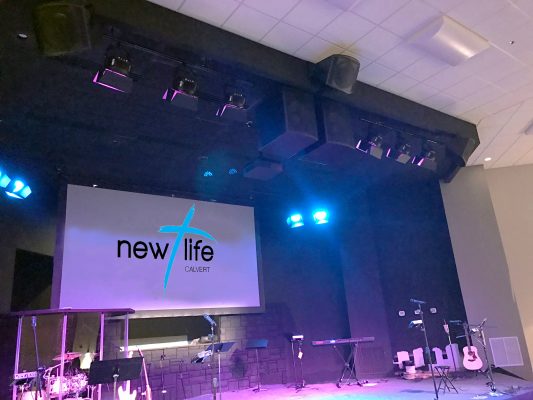Loudspeaker Placement
Speaker placement is an important – and often misunderstood – issue. The “best” loudspeaker in the world may perform poorly if not located correctly.
When in the market for a new sound system, it is best to engage a qualified designer as early as possible. A design professional will help develop a system suited to your performance and facility needs. A designer will typically create computer (acoustical) models of the space to help develop and optimize the loudspeaker system to the needs of the customer and the room. A professional will also ensure that the installation is safe and the system is properly balanced for your church’s worship style.

Two Fulcrum Acoustic CS121 21 inch Cardioid Subwoofers flown behind a CX1595 15 inch Coaxial Loudspeaker flanked by left/right CX1565 15 inch Coaxial Loudspeakers at New Life Church in Prince Frederick, Maryland.
The architectural design of a worship space is the most important factor in determining how its sound will be perceived. If the room is built as a cathedral-style with lots of hard surfaces and open air, the reverberation may be significant and the reflected energy will be a major part of the sound that the worshiper hears. If the space is constructed with lower ceilings and soft chairs, the worshiper will perceive the sound as being “dry” which may discourage singing. However, heavily amplified music can be problematic in an overly-reverberant space, so the specific worship style must be considered along with the architectural design. A balanced acoustic design that best supports your church’s music and preaching style needs to be considered.
New construction should be planned to fit the worship style of the church. If you are modifying an existing space with a new sound system, room acoustics should be considered and modified as part of the sound system design. Acoustic absorbers and diffusors can be placed appropriately during a remodel to target problem areas and enhance the listening environment. This is another key reason to engage a professional.
A key part of a successful sound reinforcement project is to ensure the loudspeakers are placed in appropriate locations relative to the stage, the listeners, and the reflective surfaces of the room. For naturalness of sound (also known as “directional realism”), loudspeakers should be located near the origination of the sound. The reinforced sound should seem to support what is naturally happening on stage, not come from another direction (e.g., behind, directly overhead, or from the far sides.) In general, the loudspeakers will be between the stage and audience seating, and higher than the listeners’ heads. This will allow the reinforced sound to travel naturally into the listening area while being perceived as coming from the stage.

Lovers Lane United Methodist Church in Dallas, Texas outfitted with Fulcrum Acoustic AH65 High Efficiency Full-Range Coaxial Horns and US212 Dual 12 inch Direct-Radiating Subwoofers
A loudspeaker’s directional characteristics (dispersion pattern) is critical as well. As discussed in earlier articles, every loudspeaker radiates sound in a particular pattern. Some loudspeakers are more directional than others. Dispersion patterns for a specific loudspeaker can vary with frequency; this must be considered along with the other performance and architectural considerations.
The dispersion characteristics for a loudspeaker result from many different characteristics of its design. Selecting loudspeakers with appropriate dispersion is an important part of the design process. If the listening area is deep and narrow, a loudspeaker with a high degree of directional control will help minimize reflected energy reaching the listeners, thereby resulting in better speech intelligibility and overall clarity.
Better dispersion control is typically associated with better loudspeaker design. The best loudspeakers will sound like all of the amplified sound originates at a single origin. Coaxial loudspeaker designs help with this by collocating the high and low frequency components at one point in space. This keeps “highs and lows” of the sound in sync as they travel toward the listener. The sound comes from one place with improved directional control
Larger horns enhance control of lower frequencies, as lower notes produce longer wavelengths. Pattern control at lower frequencies further improves clarity and speech intelligibility by increasing the direct sound reaching the listener and reducing the reflected sound (from walls, ceilings, etc.). Coaxial designs allow for larger horns with more compact enclosures. Compact coaxial loudspeakers with collocated high and low frequency components are dramatically smaller than those with offset drivers and horns. This allows them to be more easily positioned for proper acoustic alignment with the stage sound while not overwhelming the architecture.
In a nutshell:
- The room matters. It’s not just about speakers.
- Physical placement matters. Amplified sound should come from the same direction as the unamplified sound.
- Directional characteristics (dispersion) matters. Improved dispersion maximizes the direct sound and reduces reflected sound (echoes).
- High-quality loudspeakers with uniform directivity are the building blocks to a better listening experience in your worship services.
Acoustical Treatment
Older churches, in particular, were specifically designed to accentuate reverberation for traditional choral groups and/or organ music. Hard, reflective surfaces and high-vaulted ceilings are common architectural themes and, while they look beautiful, are not conducive to today’s contemporary worship style. Acoustic treatments can help minimize echo, control reverberation, and maintain audio clarity and intelligibility.
Many sanctuaries require acoustical treatments that will work for both traditional and contemporary worship. Regardless of the size of your facility, acoustic treatment is best placed where sound hits, taking into consideration not only the sound traveling from the speaker system, but also any sound bouncing from reflective surfaces and muddying the audio. While the first step of any good acoustical treatment plan is knowing the surfaces your sound will hit first (both front and rear walls, side walls, ceilings, windows), it’s necessary as well to understand what surfaces will be affected by reflected sound.
It’s also important to have a plan in place to help keep sound emanating from louder instruments like acoustic drums, electric guitars, etc., under control. Obviously, the house mix is important in taming your sound, but proper speaker and acoustical treatment in your worship space also plays a vital role.
When putting together a sound system wish list, make sure to budget for an integrator. A professional will be able to determine the best places to position your speakers, develop a strategy for main and fill loudspeakers (if required), suggest options for acoustical treatment, and help acoustically balance your sanctuary.

